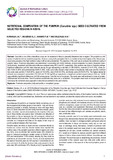NUTRITIONAL COMPOSITION OF THE PUMPKIN (Cucurbita spp.) SEED CULTIVATED FROM SELECTED REGIONS IN KENYA

Date
2013Author
Karanja, J.
Mugendi, Beatrice J.
Khamis, F.
Muchugi, A.
Metadata
Show full item recordAbstract
Cucurbita is one of the underutilized crops and its existence in Kenya is presently threatened due to neglect. The pumpkin is a rich source of nutrients and has medicinal properties. However, owing to the perception that it is a traditional food and majority of the Kenyan pop-ulace being unaware of its high nutritional value it still remains unexploited. The objective of this work was to evaluate the nutritional quality of pumpkin seeds. Proximate composition was determined in accordance with AOAC methods, mineral composition by Atomic Absorption Spec-trophotometry, tocopherol and fatty acid profile was analysed using HPLC and GC, respectively. Data analysis was done by Genstat package. Significant differences (p<0.05) were observed among the gps representing crude fibre (11.69-24.85%), crude fat (31.9-41.37%), crude pro-tein (14.05-33.29%) and carbohydrates (8.66-27.35%). Fatty acid profile showed a high content of unsaturated fatty acids and the dominant fatty acids were palmitic (1.16-20.81%), stearic (0.16-5.56%), oleic (15.56-30.79%), and linoleic acids (26.18-81.21%). The highest elemental minerals were potassium and sodium (124-335 and 70-148 mg/100 g) respectively. α-tocopherol content ranged between 8.33 and 122.65 μg/g exhibiting significant differences (p<0.05) among group 7 and the rest of the groups. The seeds were well endowed in crude oil, protein, carbohydrates and crude fibre. The oil contained unsaturated fatty acids and α- tocopherol. The pumpkin seed could be incorporated in foods to increase the nutritional value especially in diets that are deficient in the said nutrients.
URI
http://hdl.handle.net/123456789/2739http://www.worldagroforestry.org/publication/nutritional-composition-pumpkin-cucurbita-spp-seed-cultivated-selected-regions-kenya
https://www.researchgate.net/publication/283734321_Nutritional_Composition_of_the_Pumpkin_Cucurbita_spp_Seed_Cultivated_from_Selected_Regions_in_Kenya
https://bioinfopublication.org/files/articles/3_1_2_JHL.pdf
https://www.cabdirect.org/cabdirect/abstract/20143233157
Collections
- Journal Articles (PAS) [285]
